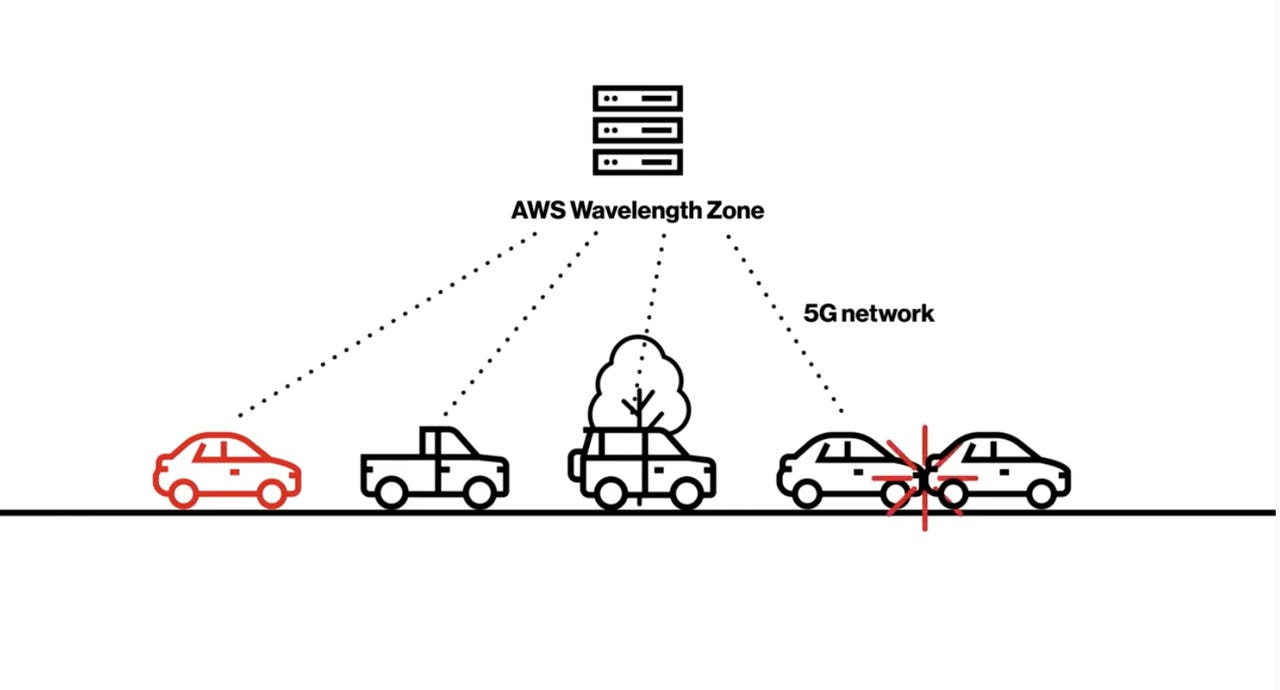Verizon, Amazon demonstrate connected vehicles using 5G, edge computing with LG, Renovo, Savari


In a car crash scenario outlined by Amazon, the AWS Wavelength edge computing service uses the 5G wireless network from Verizon to send messages from the impact vehicle back along the lane to vehicles in the rear to warn them about the car crash up ahead.
South Korean electronics giant LG, along with two California startups, is testing advanced vehicle safety technology via Verizon's 5G wireless connectivity and Amazon's AWS edge computing, Verizon announced on Wednesday.
The connected car technology, known varyingly as cellular-vehicle-to-everything, or C-V2X, and vehicle-to-everything, V2X, is being deployed by LG and by startups Renovo Motors of Campbell, California, and Savari of Santa Cruz, California, which both develop hardware and software for a variety of mobile applications.
A blog post published by AWS describes how LG has developed a prototype using the network of what it calls Authentication-as-a-Service, or AaaS, which would prevent the transmission of malicious messages to vehicles over the air.
In videos offered by Renovo and Savari, the two startups show Verizon test vehicles with computing systems in the trunk that describe using on-board sensors such as LiDAR to make cars aware of road conditions.
5G
Verizon's combination of its 5G wireless service with Amazon's AWS Wavelength edge computing platform has been rolling out city by city, with a goal of reaching ten cities in the U.S. by year's end. The deployment began in August with Boston and the San Francisco Bay Area. Service is already available in Atlanta, New York, and Washington, D.C., and today the companies announced that service has been turned on in Dallas and Miami.
"We're already seeing today how customers are leveraging the powerful combination of Verizon 5G Edge and AWS Wavelength to create next-generation use case in industries ranging from transportation to healthcare," said Verizon's head of the Verizon Business division, Tami Erwin.
LG and the other two companies are demonstrating versions of what's known as Advanced Driver Assistance Systems, or ADAS, which has been progressing through different levels of development around the world for several years now.
In the Savari video, the company demonstrates the scenario of a car crash taking place three cars ahead. Data from the vehicle in the crash would send data up to the AWS Wavelength service which would then be broadcast to the vehicle following three cars behind "in a matter of milliseconds."
In the Renovo video, a scenario called a "see through" situation, when a vehicle in the lead ahead of two other cars in a lane enacts a hard break, the third car, at the back of the pack, is warned on its dashboard about the hard brake to compensate for the fact that the driver can't see the braking car two cars ahead of it. The vehicle in the lead sends a message about its hard brake to the Verizon network, and the network in turn sends a message to the third vehicle.
The AWS blog post offers the following details of the LG application:
LG has devised a networked AaaS security solution that uses the mobile edge computing capabilities of Wavelength with an LG gateway service residing on the Wavelength platform to process and deliver vehicle safety messages in a timely manner. Special activation codes are periodically sent to disparate clients that facilitate authentication within the V2X system. LG's technology sends these activation codes via a unicast distribution model known as "uACPC," which avoids latencies associated with broadcast transmission. This leads to bandwidth savings, higher availability, and on-demand delivery of activation codes.
Edge computing